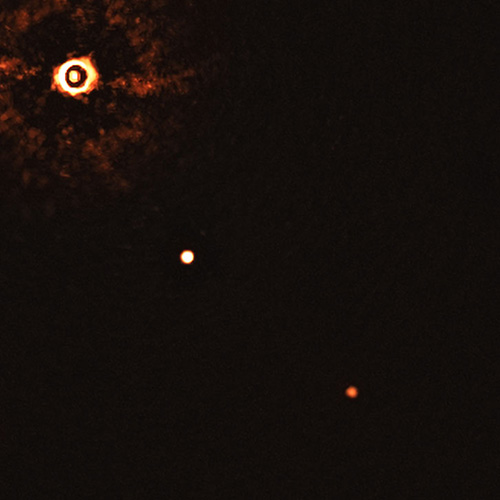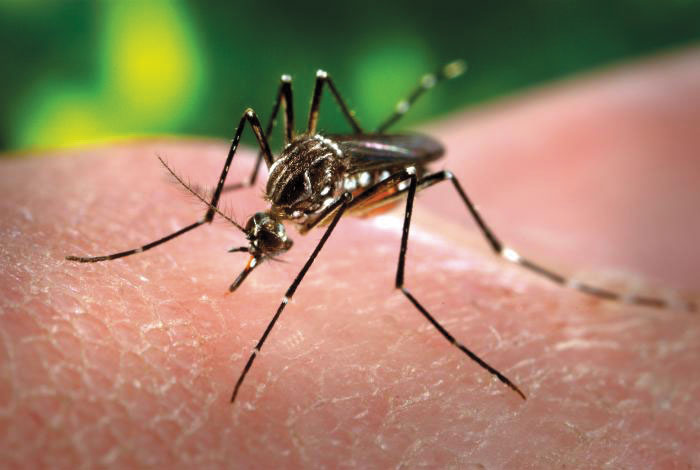
This Article From Issue
September-October 2020
Volume 108, Number 5
Page 264
In this roundup, managing editor Stacey Lutkoski summarizes notable recent developments in scientific research, selected from reports compiled in the free electronic newsletter Sigma Xi SmartBrief.
Image of a Multiplanet System
The European Southern Observatory (ESO) has released an image of two exoplanets orbiting a Sun-like star, which was captured by the Very Large Telescope in Chile. Projects such as the Transiting Exoplanet Survey Satellite have helped astronomers identify a growing number of exoplanets (see “What’s Next for Finding Other Earth-like Worlds?,” September–October 2018). However, the majority of these discoveries are based on indirect detections. The ESO release is only the third direct image of a multi-planet system, and the first such image of exoplanets orbiting a star similar to the Sun. The star, TYC 8998-760-1, is about 300 light-years from Earth. It is similar to the Sun in both mass and temperature, but is significantly younger at only 17 million years old (the Sun is approximately 4.6 billion years old). Despite the similarities of their star to our Sun, the two exoplanets are unlike any in our Solar System. Both gas giants are much larger than Jupiter and Saturn: The larger is 14 times as massive as Jupiter, and the smaller is 6 times as massive. They also have a much larger orbit than our gas giants—they travel more than 30 and 60 times farther from their star, respectively, than Jupiter does from the Sun. Because TYC 8998-760-1 is so much younger than the Sun, astronomers hope that studying it will reveal more about how star systems form.

ESO/Bohn et al.
Bohn, A. J., et al. Two directly imaged, wide-orbit giant planets around the young, solar analog TYC 8998-760-1. The Astrophysical Journal Letters doi: 10.10.3847/2041-8213 /aba27e (July 22).
Video with a Bug’s-Eye View
Engineers have developed a camera small enough to fit on a beetle’s back, or on a robot of similar size. The wireless camera weighs less than 250 milligrams and can strap onto the bug without hindering its mobility. The black-and-white, low-resolution video only captures one to five frames per second, but the lackluster image quality is made up for by the camera’s long battery life: An accelerometer triggers the camera to record only when the beetle is moving, which saves power and allows the battery to last up to six hours. The team of computer engineers at the University of Washington who designed the camera also built a robot measuring 1.6 centimeters by 2 centimeters that can carry the tiny camera while transmitting the video via Bluetooth to a smartphone up to 120 meters away. An operator can also use the smartphone to pan the camera over a 60-degree range to track objects. The tiny camera could be used by entomologists to learn more about how insects move about their environments.

Mark Stone/University of Washington
Iyer, V., A. Najafi, J. James, S. Fuller, and S. Gollakota. Wireless steerable vision for live insects and insect-scale robots. Science Robotics doi: 10.1126/scirobotics.abb0839 (July 15).
Lockdown Quiets Seismic Noise
Global social distancing and isolation efforts to slow the spread of the COVID-19 pandemic have quieted the incessant seismic hum of human activity, resulting in an unprecedented reduction in the Earth’s vibration. This drop-off in human-caused planetary trembling has enabled researchers to detect aspects of the inner Earth’s workings that are normally obscured. An international, interdisciplinary team led by seismologist Thomas Lecocq of the Royal Observatory of Belgium evaluated data from 337 seismometer stations around the world. They measured a seismic noise reduction of up to 50 percent during the period from March to May 2020 as countries and communities instituted lockdown procedures. The quieter planet gave researchers an opportunity to study subtle signals within the Earth, and it also provided a glimpse into the extent to which human activity shakes the planet.
Lecocq, T., et al. Global quieting of high-frequency seismic noise due to COVID-19 pandemic lockdown measures. Science doi: 10.1126/science.abd2438 (July 23).
Why Mosquitoes Prefer Humans
Hot, dry climates and urbanization have driven some populations of mosquitoes to acquire a taste for human blood. The Aedes aegypti mosquito originated in Africa and is now found in tropical, subtropical, and temperate regions worldwide. A team of ecologists and biologists collected Aedes aegypti eggs from 27 sites across sub-Saharan Africa. They then tested whether mosquitoes from different populations displayed a preference for the odors of guinea pigs, quail, or humans. Mosquitoes that were collected from human-biting populations were more attracted to human odors, whereas those from populations that fed on a wider variety of creatures were more likely to choose the guinea pigs or quail. These findings, combined with genetic analysis, indicate that mosquitoes’ targets are not solely based on availability: Some groups adapted to specialize in biting humans. The strongest predictor of whether a mosquito population preferred humans was climate. Mosquitoes collected from areas that have long periods of hot, dry weather were most likely to prefer humans. Aedes aegypti lay their eggs in water, and the researchers speculate that those living in arid regions are drawn to settlements where humans accumulate water for drinking, washing, and irrigation. Urbanization in Africa is likely to lead to larger populations of human-specialist mosquitoes.

Wikimedia Commons
Rose, N. H., et al. Climate and urbanization drive mosquito preference for humans. Current Biology doi: 10.1016/j.cub.2020.06.092 (July 23).

American Scientist Comments and Discussion
To discuss our articles or comment on them, please share them and tag American Scientist on social media platforms. Here are links to our profiles on Twitter, Facebook, and LinkedIn.
If we re-share your post, we will moderate comments/discussion following our comments policy.